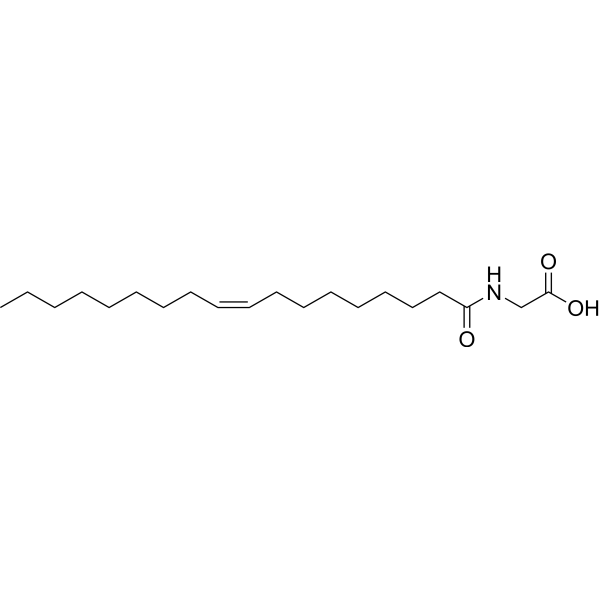
N-Oleoyl glycine
CAS No. 2601-90-3
N-Oleoyl glycine( —— )
Catalog No. M26577 CAS No. 2601-90-3
N-Oleoyl glycine, a lipoamino acid, was able to promote 3T3-L1 adipogenesis through the activation of CB1 receptor and the enhancement of insulin-mediated Akt signaling pathway.
Purity : >98% (HPLC)
 COA
COA
 Datasheet
Datasheet
 HNMR
HNMR
 HPLC
HPLC
 MSDS
MSDS
 Handing Instructions
Handing Instructions
| Size | Price / USD | Stock | Quantity |
| 5MG | 35 | In Stock |


|
| 10MG | 58 | In Stock |


|
| 25MG | 88 | In Stock |


|
| 50MG | 138 | In Stock |


|
| 100MG | 206 | In Stock |


|
| 200MG | 308 | In Stock |


|
| 500MG | Get Quote | In Stock |


|
| 1G | Get Quote | In Stock |


|
Biological Information
-
Product NameN-Oleoyl glycine
-
NoteResearch use only, not for human use.
-
Brief DescriptionN-Oleoyl glycine, a lipoamino acid, was able to promote 3T3-L1 adipogenesis through the activation of CB1 receptor and the enhancement of insulin-mediated Akt signaling pathway.
-
DescriptionN-Oleoyl glycine, a lipoamino acid, was able to promote 3T3-L1 adipogenesis through the activation of CB1 receptor and the enhancement of insulin-mediated Akt signaling pathway.(In Vitro):N-Oleoyl glycine stimulated lipid accumulation and significantly increased adipogenic genes (PPARγ and aP2), in a dose- and time-dependent manner.?Additionally, N-Oleoyl glycine markedly increased the mRNA expression of CB1 receptor and the inhibition of CB1R by its antagonist SR141716 abolished the promotive effects of N-Oleoyl glycine on lipid accumulation and the protein expression of PPARγ and aP2.?Furthermore, N-Oleoyl glycine increased the ratio of p-Akt/Akt and p-FoxO1/FoxO1, which could be reversed by SR141716.?Moreover, N-Oleoyl glycine-induced enhancement of adipogenesis, activation of insulin-mediated Akt signaling pathway and inactivation of FoxO1 were effectively blocked by Wortmannin, a specific PI3K/Akt inhibitor, indicating the essential role of Akt signaling pathway in the process of N-Oleoyl glycine-stimulated 3T3-L1 adipogenesis.
-
In VitroN-Oleoyl glycine is a lipoamino acid, which stimulates adipogenesis associated with activation of CB1 receptor and Akt signaling pathway in 3T3-L1 adipocyte. N-Oleoyl glycine (1, 5, 10, 20, 50 μM) dose- and time-dependently stimulates 3T3-L1 adipogenesis after treatment for 1-10 days via activation of CB1R. N-Oleoyl glycine also elevates Akt signaling pathway during the differentiation of 3T3-L1 adipocytes.
-
In Vivo——
-
Synonyms——
-
PathwayGPCR/G Protein
-
TargetCannabinoid Receptor
-
RecptorCYP3A
-
Research Area——
-
Indication——
Chemical Information
-
CAS Number2601-90-3
-
Formula Weight339.52
-
Molecular FormulaC20H37NO3
-
Purity>98% (HPLC)
-
SolubilityIn Vitro:?DMSO : 100 mg/mL (294.54 mM)
-
SMILESCCCCCCCC\C=C/CCCCCCCC(=O)NCC(O)=O
-
Chemical Name——
Shipping & Storage Information
-
Storage(-20℃)
-
ShippingWith Ice Pack
-
Stability≥ 2 years
Reference
1.Method for increasing HDL cholesterol levels?using?heteroaromatic phenylmethanes. United States Patent 6103733
molnova catalog



related products
-
N-Oleoyl glycine
N-Oleoyl glycine, a lipoamino acid, was able to promote 3T3-L1 adipogenesis through the activation of CB1 receptor and the enhancement of insulin-mediated Akt signaling pathway.
-
APD-371
APD-371 (APD371, Olorinab)?is a potent, selective and orally available CB2 agonist with EC50 of 6.2 nM; displays no activity against CB1 receptors (EC50>10 uM).
-
GW 833972A
GW 833972A is a selective CB2 receptor agonist that inhibits induced neural depolarization and citric acid-induced cough in an animal model.



 Cart
Cart
 sales@molnova.com
sales@molnova.com


